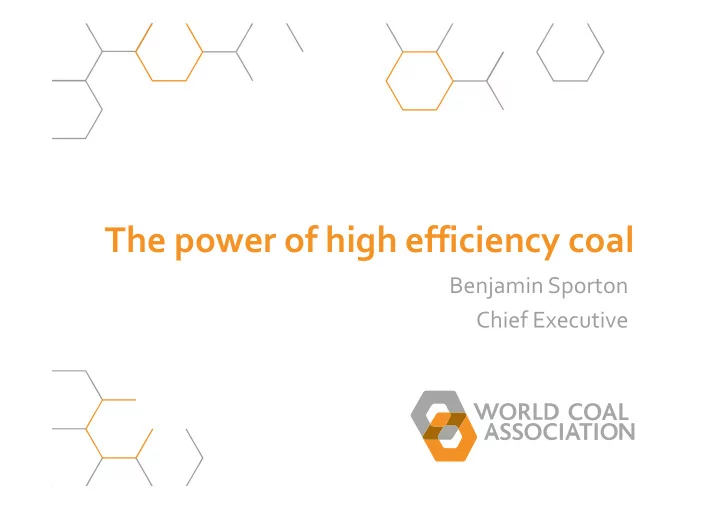

The power of high efficiency coal Benjamin Sporton Chief Executive
Coal continues to grow, even as share declines
Asia will drive new coal generation capacity Asian share of global coal power generation capacity: 2000 – 38% 2015 – 69% 2040 – 77% Will require an additional 1 billion tonnes per annum of coal
Large ‐ scale power generation will be a critical enabler of growth in India Electricity demand in India is expected to average 4.4% pa over the next 25 years While coal generation capacity more than doubles, renewables are required to increase exponentially (non ‐ hydro renewables over 10 times) to meet demand IEA indicates that maintaining an adequate electricity supply represents a significant investment challenge requiring $2 trillion (in 2013 dollars)
Coal will continue to play a big role in China China’s electricity demand growth will be around 4.8% to 2020, then decline to around 2% through to 2040 Electricity generation from coal will be 27% higher in 2040, despite its share of generation reducing from 75% to 49% Non ‐ hydro renewables are expected to increase 1200% over the same period (25% of world generation)
Coal will drive Southeast Asian energy Electricity demand almost triples over the period, to around 2 000 TWh in 2040, an increase bigger than current demand in India. The share of coal in power generation rises from 32% to 50% Renewables ‐ based electricity generation increases three and half times from today to 2040 (481 TWh) IEA – requires $2.4 trillion investment over the period to 2040. This represents around 5% of the global total, or one ‐ third of China’s investment Southeast Asia will move from 46% to 60% urbanised by 2040, vs OECD 85%
Higher efficiency reduces CO2
HELE technologies continue to develop
What is high efficiency low emissions coal?
HELE can become the global standard for coal Japan and China have been the most active in building USC plants J ‐ Power upgraded their 1967 sub ‐ critical Isogo 38% efficient coal ‐ fired power plant to an USC 43% efficiency plant with SOx, NOx, PM reduced to less than 1/3 of previous levels China’s Ninghai plant has a capacity of 4,400MW and China is relying on these larger, advanced units for dispatch to displace higher emission from older, less efficient power stations The units have integrated advanced air quality control systems, yielding non ‐ carbon air emissions well below China’s latest more stringent standards, and also below comparable standards in North America and Europe
WCA wants to see more action on HELE
HELE is part of the Paris Agreement
Coal plant development mix of HELE and not
China committed to HELE, others less so
Non ‐ OECD Asia needs to make HELE switch
HELE is cost competitive today…
… and in the future (and so is coal+CCS)
Per $ of investment HELE more powerful
HELE in India – meeting twin objectives
HELE in India – examining the impact
WCA supports coordinated international action International platform to help drive deployment of HELE technologies in developing and emerging economies Public private partnership to overcome financial, technical and regulatory barriers Currently seeking partners to help build an initial alliance
A global initiative on HELE would have impact
Deploying HELE also has other benefits Air quality CCS
CCS is critical to global climate objectives CCS is expected to deliver 12% of cumulative GHG emissions cuts through to 2050. It is therefore a key low ‐ carbon technology The world’s first large scale integrated CCS project capturing CO2 from a coal ‐ fired power plant – SaskPower’s Boundary Dam – has just started full scale operation at the end of September 2014
Why CCS has been slow to progress
CCS is real, and happening now The world’s first application of CCS at large scale in the power sector became operational in October 2014, at the Boundary Dam power station in Canada (1 Mtpa CO2 capture) An upgrade of a 1960’s coal unit chosen by Saskpower over gas and renewables Two more large scale applications of CCS in power will come on line in 2016 in the US Boundary Dam, Saskatchewan, Canada Kemper County Energy Facility (3 Mtpa, Mississippi) Coal ‐ fired 110MW CCS 1Mtpa plant Petra Nova Carbon Capture operational October 2014 Project (1.4 Mtpa, Texas) $1.4Bn Government and Saskatchewan Large ‐ scale application of CCS will Power Co partnership become a reality in iron and steel in 2016 at the Abu Dhabi CCS Project (0.8 Mtpa) A further 14 projects are in advanced planning (FEED)
In summary – the WCA view We must recognise that coal is an important driver of affordable, reliable energy to support economic development and competitiveness Coal plays a major role in industrialising and urbanising economies In any scenario coal is still going to play a major role in the world’s energy mix – especially across Asia We can significantly reduce emissions from coal with commercially available technology today – we should encourage and support deployment of HELE technologies in preference of less efficient technologies More public support is needed to facilitate increased commercial demonstration of CCS to drive costs down so that we can begin a transition toward near ‐ zero emission fossil fuels
www.worldcoal.org info@worldcoal.org
Recommend
More recommend